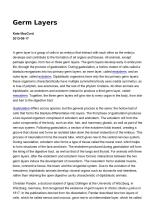Filter my results


When cells-but not DNA-from two or more genetically distinct individuals combine to form a new individual, the result is called a chimera. Though…
ContextChimerismEmbryosEmbryonic Stem CellsMosaicism
First published in 1930 and reprinted in 1972, Edward Stuart Russell's The Interpretation of Development and Heredity is a work of philosophical and…
LiteratureHeredityPublications
The Spemann-Mangold organizer, also known as the Spemann organizer, is a cluster of cells in the developing embryo of an amphibian that induces…
EmbryosAmphibiansSpemann, Hans, 1869-1941EmbryologyGastrulation
The encyclical entitled "Evangelium Vitae," meaning "The Gospel of Life," was promulgated on 25 March 1995 by Pope John Paul II in Rome, Italy. The…
LiteratureJohn Paul II, Pope, 1920-2005religionReproductionCatholicism
A PhD and medical doctor turned ethicist, Leon Kass calls himself an unlicensed humanist. Throughout his unique career he has sought to impact others…
PeoplebioethicsethicsReproductionBiography
A germ layer is a group of cells in an embryo that interact with each other as the embryo develops and contribute to the formation of all organs and…
GastrulationEmbryologyCell differentiationEmbryosCells
Ectoderm is one of three germ layers--groups of cells that coalesce early during the embryonic life of all animals except maybe sponges, and from…
EmbryosEmbryologyGastrulationCellsTissues
Pope Innocent XI, born Benedetto Odescalchi, made considerable contributions to the Roman Catholic approach to embryology by condemning several…
PeoplereligionReproductionCatholicismPopes
Sir John Bertrand Gurdon further developed nuclear transplantation, the technique used to clone organisms and to create stem cells, while working in…
Cell nuclei--TransplantationCellsCloningStem CellsEmbryonic Stem Cells
Andrew Francis Dixon studied human anatomy and egg cells at the turn of the twentieth century in Ireland and Great Britain. Dixon studied the sensory…
Nerves, CranialPolar BodiesMeiosis